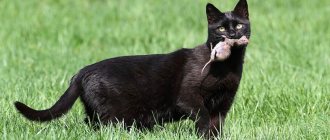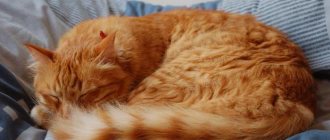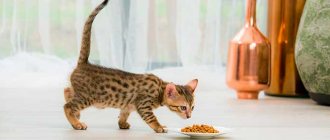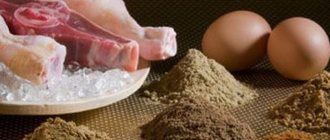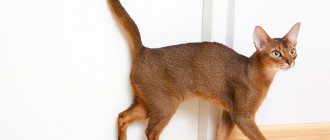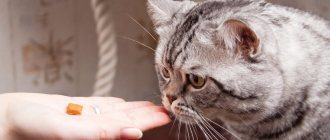Kittens that are old enough to eat food on their own copy the habits and preferences of their mother. However, most often, by the time they feed on their own, they are separated, and therefore the owners have to pay due attention to the diet of the young predator.
As the kitten grows up, baby food fades into the background, and the owners decide to teach their grown pet to eat dry food. And here a surprise may await them - the kitten can easily refuse the proposed menu! What to do? The staff of the Murkosha shelter are ready to give some useful advice.
Dry food introduction period
Before introducing a kitten to dry food, you should think about what age is best to do this.
Veterinarians advise:
- at the age of 1-1.5 months, together with the cat’s mother’s milk, or its substitute;
- over 2.5-3 months of age, when the digestive system is ready to process dry food pellets.
If you offer dry food to kittens that are bottle-fed and have not reached the age of 2.5 months, the development of the digestive organs will go wrong, resulting in a reduction in the animal’s life expectancy. Older kittens can be given dry food without worry.
Where to start on the road to dry food?
As practice shows, about 35% of kittens independently switch to dry food, provided they have free access to clean drinking water, because there is no liquid in the food! This means that there are no special problems.
However, the remaining 65% of kittens flatly refuse the proposed menu. In this case, you should slowly accustom your pet to the desired diet according to a certain scheme. If you follow simple rules, the transition process takes 15 days.
Begin to introduce dry granules gradually, with a few pieces added to the food:
- children's meat pates are mixed with several food granules;
- dry food is diluted with baby milk formula;
- The kitten is delayed from serving the portion for 1-1.5 hours, and then first offered dry food, and only then the usual food.
This start will allow the kitten to become familiar with new food and appreciate its benefits. The main thing here is not to shout or force the kitten, otherwise instead of quick training you will get big problems.
Tips for feeding cats
Experienced veterinarians identify several basic rules when feeding cats:
- There is no need to mix dry food and canned food in one feeding.
- 2If the animal is fed on feed, it must be premium. Feeding an animal with expensive food is many times cheaper than spending money on treatment after using cheap analogues.
- There is no need to get carried away with wet food - if used frequently, they provoke obesity. They go as a dessert, sometimes you can pamper your beloved pet, but nothing more.
- Dry food lovers should always have a bowl of clean drinking water. Wet food consists of 70% water, but dry food contains much less water. In order for the animal to receive adequate nutrition from dry food, it needs to drink a lot. If a cat doesn't drink enough water, it will affect its well-being. If the condition worsens, you should urgently show the animal to a veterinarian.
- Without compelling reasons, there is no need to change feed frequently, and if this is a necessary measure, then follow the rules outlined above.
- Do not feed food strictly according to the norms indicated on the box. The cat will eat as much as she needs, she will leave the excess in the bowl, but starvation leads to a number of diseases.
- If you feed your cat natural products, then do not forget to add vitamins and minerals to the diet.
A veterinarian will help you perfectly balance your animal’s diet.
How to move forward to dehydrated food?
If a start has been made and the kitten has begun to eat dry food, it is worth putting dry food granules in a bowl between feedings. The main thing is, do not forget to add clean water to the drinking bowl in time, because the cat’s body will have to spend a lot of water to soften the food granules.
Standard scheme for accustoming to a new diet in 15 days: on the first day, you add about 1/10 of the dry granules to the food you were used to at that time, gradually increasing the proportion of dry food to 100% on the 15th day. If at any stage the process freezes, reduce the concentration to the previous one and switch to a smoother pace.
Important:
- calculate the serving size according to the weight and age of the kitten;
- Always keep a bowl of clean water next to the food;
- Give only fresh food, without mixing it with leftover food in the bowl.
Typical mistakes in introducing dry food
For some reason, many kitten owners are sure that there is no need to accustom their pet, and that the kitten itself must guess that the food offered is nothing more than its breakfast, lunch or dinner. Most likely, such owners are guided by the principle “if you want, you can eat whatever.”
However, this is a bad strategy. Firstly, it is ineffective, and secondly, a kitten with its sensitive digestion and weak immunity will easily develop serious health problems, which the owner will have to solve.
That's why:
- You should never punish a kitten for refusing dry food;
- It is prohibited to force an animal to dry food;
- You cannot speed up the process at will.
Possible problems when accustoming a kitten to dry food
In some cases, kitten owners are faced with a situation where a pet that has begun to actively get accustomed to dry food suddenly refuses to eat. This may be due to a lack of clean water in the drinking bowl. As already mentioned, with a dry diet, the kitten should have unlimited access to drink, since a large amount of moisture is spent on softening the granules.
The second problem that prevents you from accustoming a young cat to dry food may be mixing old and new portions of food. The food left over from the previous meal acquires an unpleasant smell for the kitten, so he refuses it.
To prevent this from happening, you should:
- correctly calculate the serving volume;
- wash the cat's bowl after feeding;
- offer other “meals”, including cat treats, in a separate bowl.
The third problem is improper storage of feed. Factory packaging that does not have special fastenings is not suitable for this after opening in principle, since the food can deteriorate and the aroma is lost.
And food that does not smell is no longer food for a kitten. The solution here is a special container with a tight lid for storing food, which can be bought in any household goods department.
Should I buy my cat dry food or feed it from the table?
Just like people, cats need daily nutrition. But, since they are still not people, their nutritional needs differ from ours.
Is it possible to feed a cat food from your table?
When you eat, your cat sits and looks at you intently, and even more so, reaches his paw into your plate; rarely can anyone refuse to give him something from his dinner. Before you offer him something, decide what it will be. If you don’t know how a cat’s stomach can tolerate a particular product from your table, then first familiarize yourself with the composition of the dry cat food you feed it. If you give your pet food, for example, based on chicken, and it does not cause an allergic reaction in the cat, then you can safely treat your cat to a piece of steamed or boiled chicken from your plate. That is, read what ingredients the cat food she eats is made from, and you can occasionally gradually feed your pet products known to its gastrointestinal tract. Of course, they should not be sour, salty or spicy.
Some, especially Canadian, dry cat foods may contain various herbs and berries. You can certainly offer fresh or dried blueberries or alfalfa to your cat, but don't be surprised if he just plays with them and quickly loses interest in them. Such optional and non-edible ingredients for cats in American-made commercial foods (Acana, Go, Orijen, etc.) are added to them, as they think, in order to improve the nutritional value of the final product. In fact, if your cat never chews “freshly sun-dried alfalfa” or gnaws “freshly picked blueberries” in her life, this will not affect her health, quality or life expectancy in any way. But, if you occasionally offer her boiled rice in meat broth, then it is quite possible that she will not refuse such a gift.
If you want to give your cat a product that she has never eaten before and it is not contained in her daily food, then this must be done very carefully and a little, or better not at all. Read this article about what you should never feed your cat.
It is important to understand that individual table foods should only be a small addition to your cat's main dry diet. They will not be able to compete with ready-made dry food in terms of the complexity of its composition, especially if it is high-quality cat food. And what may be tasty, harmless and familiar to you, will be harmful and dangerous to health for a cat.
Is it possible to mix different cat foods and change them?
Of course, yes - not only can they be changed and mixed, often, it even needs to be done! Those who say otherwise are either producers of low-quality pet food, or pet stores and veterinarians who sold them “their souls” for pennies.
To make sure that eating the same thing for a long time is unpleasant, just try to eat this way yourself.
Any commercial dry cat food , no matter how balanced it may be, cannot contain all the necessary substances in constant quantities throughout the entire shelf life or storage. Thus, there is always less or more of something in one food than in another and vice versa.
The main thing to consider when choosing a dry diet for your pet is its quality and cost.
What is the best quality cat food?
High-quality dry or wet food means that:
- produced primarily from good meat in large quantities
- made taking into account the age, activity and physiological state of the cat
- does not contain processed products of forced slaughter, hormones, attractants, artificial preservatives and harmful dyes, GMO soybeans, corn and potatoes
- has a quality certificate issued by the most independent structure for monitoring the production and quality of food products
- has a cost equal to the quality of the food, and not the popularity of the brand, the price of packaging or its advertising
- aims to maintain the health of the cat.
Which food to choose?
The correct choice of dry food determines whether the baby will get used to the new diet and how the change in menu will affect his health. Veterinarians advise buying food that is produced specifically for kittens. Moreover, it will be easier to accustom cats to a new menu with them.
Almost any brand's product line includes specialized dry food for kittens. It is important to choose a super premium or holistic food that meets the needs of the carnivorous animals that are cats.
What is the best food for a cat?
Complete food in the form of dry food is designed specifically to ensure that the cat receives all the necessary substances, vitamins and microelements. So if you feed the animal something else, you can create an imbalance in the body. It is often difficult for owners to calculate how much protein, fat, carbohydrates and other substances a cat needs, and if you feed the animal thoughtlessly, you can cause a deficiency or excessive content of any substance in the cat’s body. That is why you should not experiment with mixed food, but give your beloved pet high-quality and balanced dry food, which will undoubtedly be beneficial and your cat will like it.
Monitor your pet's reaction
When introducing a kitten to dry food, carefully monitor what is happening. If the baby is cheerful and active, gains weight well, and his gastrointestinal tract works like a clock, then the diet has been chosen correctly.
If your pet has loose stools or constipation, allergy symptoms (itching, rash, hair loss), you need to pause the transition to a new diet and seek advice from a veterinarian.
Sources:
https://murkosha.ru/nashi-stati/soderzhanie-i-ukhod/kak-priuchit-kotenka-k-sukhomu-kormu
https://www.acana.ru/kak-priuchit-kotyonka-k-suhomu-kormu
Dosage helps to properly feed your cat dry food
The main role in how to properly feed a cat dry food is played by dosage. The amount of feed required by the animal can be seen in the table indicated on the packaging. Knowing your cat's weight, you can easily determine the optimal amount of food for her, and then adjust it according to the individual needs of the animal.
So, for sedentary pets it is necessary to adhere to the minimum values, for active ones - to the maximum. Then you need to carefully monitor your cat and adjust the amount of food if she loses or gains weight.
In order not to weigh the dose of food each time, you can make a plastic measuring cup. Having measured the required amount using a kitchen scale, mark its level on the surface of the glass and use it as a weight standard.
The daily ration can be given once, for example, in the evening feeding, or divided into two doses - half in the morning and half in the evening. During the day, the cat will gradually eat its portion. If the bowl is quickly empty, you don’t have to worry about your pet being hungry.
The cat cannot know for itself how much it needs. There are small cats, and there are gluttons. In nature, a predator tracks and hunts for prey for a long time, eating as much as it can get. But apartment conditions are very different from natural ones. Pets need nutritional control, so the owner needs to know how to properly feed the cat dry food.
